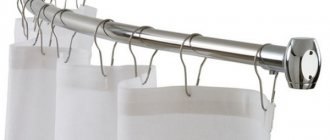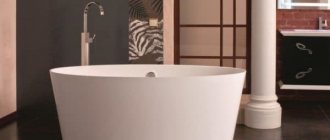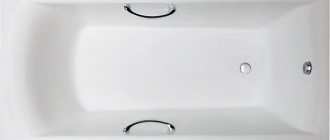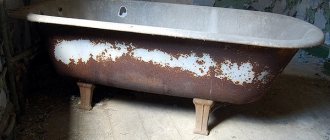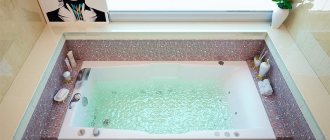Some people laugh at the small-sized apartments that appeared during Khrushchev’s times. But for many families this was the only real opportunity to become owners of their coveted home. And the size of the same bathroom at that time did not matter much to them.
To be honest, even today they do not play a decisive role, if you manage to manage this premises competently. For example, you can use a shower stall in a small bathroom. A sitz bath is also a great solution. Immediately frees up space for the washing machine. Let's consider this option in more detail.
The main differences between sitz baths
Today, sitz baths in certain cases are not a disadvantage of a small room, but a necessity dictated by old age or illness of one of the family members. More specifically, sitz bathing is absolutely necessary:
- for gynecological ailments, as well as problems of the genitourinary system;
- for disabled people suffering from problems with the musculoskeletal system, as well as people of advanced age;
- for skin diseases;
- for heart diseases;
- in case of circulatory or digestive problems;
- for nervous disorders;
- people suffering from diabetes.
Note! To speed up the recovery of a family member, as well as to make changes to the interior, you can purchase and install a sitting structure, a photo of which you will find in this article.
In small bathrooms, small bathtubs are still very relevant; moreover, if the need arises, they can be installed even in ordinary bathrooms as an auxiliary plumbing fixture. Of course, it is not easy to take a traditional shower in such a bath, so a regular shower stall can be located nearby (of course, if the free space allows it).
Sitz acrylic baths
There is no need to be upset if the apartment has a small room for a bath, and the family’s modest income does not allow them to fork out for an interior made from natural materials. We should not forget that the acrylic bathtub has firmly entered the leading range of modern plumbing.
Sitz acrylic bathtubs of fancy shapes and various colors are produced by the world's best manufacturers. A small acrylic bathtub can completely transform a room, making it chic and exclusive. What is needed for this?
You just need to take a closer look at the relatively inexpensive, high-quality imitations of expensive materials such as natural silk, marble, and onyx. A bathroom covered with waterproof wallpaper imitating silk and decorated with artificial marble or onyx looks prestigious.
Prestige is reinforced by “gold” or “bronze” round-shaped taps and a skillfully decorated and color-matched acrylic sit-down bathtub mounted on lion paws.
It would also be appropriate to use inexpensive natural stone for decoration.
The interior will be completed by subdued lighting, creating mysterious intimacy and comfort.
Review of popular models of sitz bathtubs – features, parameters and prices
Let's take a look at some of the models that were popular at the time of publication of the article. We will not focus on any one manufacturing material - we will try to cover the entire range. For the convenience of visitors, all information is presented in the form of a small table.
Table. Review of some models of sitz baths.
| Name, photo | Main characteristics | Average market value, in rubles |
| 1. Roca Banaseo 100×70 | Cast iron seating structure from a well-known Spanish manufacturer. The volume of the bowl here is 88 liters, and the dimensions of the bath itself are 43x70x100 centimeters (height, width and length, respectively). | From 27190 |
| 2. Aquanet Fregate | High-quality acrylic model of joint Russian-Slovenian production. Corner type, with side massage and the possibility of installing a hydromassage system. Capacity – 210 liters, dimensions – 120x120 centimeters. | 15 767 – 31603 |
| 3. Radomir Taharat | Domestic acrylic model of rectangular shape. The color of the product is white. The dimensions of the model are 120x80 centimeters. | 23850 |
| 4. Alpen Nila 120×120 | Another model, this time a joint Austrian-Polish production. Still made of acrylic (a very popular material), the dimensions of the product are 120x120 centimeters. | 28760 |
| 5. Relisan Polina | Polish sitting model made of acrylic corner type. The capacity of the bath is 200 liters and the depth is 43 centimeters. Product dimensions – 120x120 centimeters. | 19505 |
| 6. Alpen Mars 120 | Another model from the manufacturer mentioned above, still made of white acrylic. The volume of the bowl in this case is 135 liters, and the design dimensions are 120x70 centimeters. The shape is rectangular. | 11630 |
| 7. Akrilan Laguna del Tesoro | Corner design of domestic production, acrylic, aero- and hydromassage functions are provided. The volume of this model is 200 liters, and the dimensions are 120x120 centimeters. | 14 645 – 67940 |
Offers from the best manufacturers
Bathtubs designed for bathing in a sitting position are produced by many reputable companies. Traditional cast iron models are supplied to the plumbing market by Roca from Spain. She completes her models with legs. As additional accessories, it comes with a seat and steps.
Roca Banaseo with dimensions 100 x 70 cm is an excellent solution for small rooms. Its small dimensions do not affect the quality. With a depth of 0.43 m, the model holds up to 88 liters of water
Another miniature model is the Roca CONTINENTAL with a height (including legs) of 0.57 m and a depth of 0.42 m. The capacity of 95 liters has a durable enamel coating applied using the “hot technology” principle.
Rectangular built-in or triangular steel bathtubs from Emalia come to our market from Poland. They are distinguished by a high-quality snow-white coating. With a depth of 36 cm and dimensions of 1 x 0.7 m, the bowl has a volume of 97 liters.
The Antica bathtub is produced by a Russian manufacturer. This free-standing sanitary ware, made of steel, has a glass-ceramic coating
The Bach Laura bathtub from Russian is also designed for small bathrooms. It has a rectangular shape with sides 1.2 x 0.7 m. Made of acrylic, equipped with hydromassage.
Domestic also produces small-sized acrylic bathtubs with parameters of 1.2 x 0.7 x 0.625 m. These bowls are produced in three versions: built-in, with legs, and with a mounting frame. Some models are equipped with aero- or hydromassage and other devices.
Aquanet Fregate acrylic models, a Russian-Slovenian product, are popular. This corner model has a large capacity of 120 liters and a side massage. The more additional options a product has, the more expensive it is.
About the functionality of a sitz bath
In this case, functionality means additional features - useful options that allow you to get the maximum level of comfort during water procedures, as well as expanding standard capabilities.
These include:
- installation of hydromassage;
- installation of a player/receiver to listen to music during water procedures;
- installation of air massage;
- arrangement of special lamps necessary for non-traditional treatment (photo and light therapy).
Note! Depending on the number of these additional options in the model you choose, its final cost decreases/increases.
Sitz baths: prices and the main factors that shape them
Prices for sitz baths vary widely. The main indicators influencing pricing are:
- material of manufacture;
- technology. Some acrylic bathtubs with the same size and shape have a 30% difference in price. Most often this is due to the number of reinforcing layers;
- size and shape;
- design feature: presence of screen, headrest, handrails, additional options;
- brand.
Acrylic rectangular sitting bathtub 120x70 cm Besco Majka Nova WAM-120-PK made in Poland costs 11,450 rubles. The same domestically produced product Aquatek Mia has a price of 10,200 rubles. Czech goods with similar dimensional indicators are valued at 28,320 rubles.
There are many indicators that influence pricing
A Russian-made Donna Vanna steel bathtub 120x70 cm costs 5,400 rubles. The cost of a cast-iron domestic bathtub of similar size “Universal” is 12 thousand rubles. The Chinese cast iron version is estimated at 17 thousand rubles.
The price of corner sitz baths is significantly higher . It is difficult to make an exact comparison with the classic ones, but with the same volume, material and manufacturer category, the cost is 40-50% more. Exclusive models equipped with massage functions and a door can have a price of 50-100 thousand rubles.
Sitz baths - possible sizes
You will be able to choose the most suitable bathtub for each specific case, since modern manufacturers have ensured that on the market you can find high-quality models of any size, shape, design, as well as materials used in manufacturing. There are many possible sizes, but the most popular are the following:
- 70x100 centimeters;
- 70x120 centimeters;
- 70x150 centimeters;
- 110x120 centimeters.
It should also be noted that a sitz bath can have any configuration; it can be equipped with handrails, steps, comfortable seats and many other devices that turn routine water procedures into moments of true pleasure. For example, backlit models or designs that are recessed into the floor look great. But at the same time, you must remember that a bathtub with non-standard dimensions will cost more (more about prices a little later).
Video - Sitz baths that are built into a niche
Dimensions
It is difficult for a non-professional to understand what size bathtub can be considered small, and whether it can be comfortable for use. When determining the product category, manufacturers usually start from the standard dimensions of the washing container, which has a length of 150-175 cm and a width of 70-75 cm. A small corner or regular bathtub is usually installed for one purpose - to save free space in a cramped room, so it is slightly smaller standard:
- The length of a small font is usually 120-150 cm. This size does not allow you to take a bath while lying down, but you can use it while sitting or reclining. Tall people may have problems with a short washing container.
Bath 120 by 70 - The width of compact models is 55-70 cm. Thanks to the narrow shape of the bowl, the space required for installing household appliances is freed up. However, in models with this width, people with large weight may feel constrained.
- The depth of small baths does not differ from standard ones; it is 60-56 cm, which will allow a person to be completely immersed in water.
Important! When purchasing a small bathtub, it is necessary to find a rational compromise between compact dimensions, suitable for tight spaces, and comfort of use. The most convenient shape for a small-sized font is considered to be angular. An asymmetrical or symmetrical corner bowl equipped with built-in storage can significantly save space in a small bathroom.
What shape can the structure take?
And the shape of a sitz bath can be very diverse. These can be, for example, standard rectangular structures, as well as round or oval. The best option for a small bathroom is a triangular corner seat design. And if you want to simplify the ablution process for an elderly member of your family, we recommend giving preference to a model equipped with a door. The last bath can save a person from the time-consuming (and in some cases it really is) step over the side - instead, he will enter through the door, and then, after closing it, he can draw hot water. When the procedures are completed, the water will need to be drained, and only then can the door be opened.
Seated structures with hydromassage systems are extremely popular today - they are distinguished by the fact that they perform several functions simultaneously (cleanse the body, restore the elasticity of blood vessels and normalize blood circulation; they also stimulate the functioning of the digestive system, kidneys and heart).
Also, the baths described may vary depending on the material used in manufacturing; from this point of view they can be:
- cast iron;
- steel;
- acrylic.
Let's take a closer look at each of the categories. Let's start with the first one.
Dependence of bath weight
The weight of a cast iron bathtub is directly related to its dimensions and model. Thanks to new technologies, cast iron bowls are lighter than they were 40 years ago.
Table
| Standard cast iron bathtub weight(kg) | ||||
| Length(cm)/width(cm) | 70 | 75 | 80 | 85 |
| 150 | 80-90 | 90-100 | 100-110 | 110-120 |
| 160 | 85-95 | 95-105 | 105-115 | 115-125 |
| 170 | 95-110 | 110-125 | 125-140 | 135-145 |
| 180 | 115-135 | 130-150 | 145-165 | 160-180 |
Example
For comparison, a Soviet-era bathtub measuring 150 cm by 70 cm weighed 120 kg.
For your information. Products from foreign manufacturers, in particular Chinese, are lighter. This is due to the fact that the manufacturer skimped on materials and did not follow casting technology.
Imported bowls are usually small, up to 40cm deep. It is difficult even for the average person to lie in such a bath.
There are many companies that produce bathtubs made of cast iron of excellent quality. Where the material meets all requirements and has excellent characteristics. When purchasing a cast iron bathtub, you should carefully familiarize yourself with the manufacturers.
Imported bowls can meet all requirements and be thinner and lighter at the same time. The walls of the bathtub according to the standard are no higher than 1 cm.
Advantages of cast iron baths
Strength.- Long service life.
- Not deformed.
- Low thermal conductivity.
- The enamel coating is aesthetically pleasing and, with proper care, will last a long time.
- The enamel is resistant to chemicals.
- Loyal price.
Disadvantages of the product
- The coating is not resistant to mechanical damage.
- Transportation and installation are complicated.
- The product does not have perfect symmetry.
It takes a long time to warm up. If you decide to take a bath, you will have to wait.
Dimensions
- Soviet baths were made 120, 150, 170 cm in length.
- Modern 80-180cm.
- Standard width 70-75cm
- Modern 60-80 cm
- The usual depth is 40-50 cm.
- Modern products up to 60 cm deep.
Manufacturers
- 170-75 cm weight 114 kg. Novokuznetsk
- 150-70 cm weight 104 kg Kirov
- 150-70 cm weight 73 kg
- 170-70 cm weight 121 kg
Casting cast iron is a rather labor-intensive and complex process; for this reason, most products have standard shapes.
Cast iron models are timeless classics
Sedentary models made of cast iron can rightfully be considered a leader in the ranking of plumbing fixtures, since they have all the advantages required for carrying out full-fledged medical procedures.
In particular, these benefits include:
- long service life;
- resistance to rust and various types of mechanical damage;
- reliability;
- high strength indicators.
Note! Cast iron bathtubs of a sit-down design maintain the required water temperature for a long time, in addition, they weigh a lot, which ensures their stability (and this is important for safe water procedures).
On the modern market there are small cast iron structures, including those equipped with doors. They usually cost more than models made from other materials, but they will not require replacement or major repairs for at least several decades. If you wish, you can purchase/order a bathtub of a non-standard shape, but this will increase the price even more.
Classification, parameters and dimensions
Modern versions made of cast iron, made in Russia, are available in lengths of 150–180 centimeters and widths from 70 to 85 cm, so it is easy to calculate the weight of a cast iron bathtub. Modern bath models have the following classification
:
By size (in centimeters)
| Length | Width | Depth | How much does the iron model weigh (kg) | |
| Small (sessile) | 120 | 70 | 36 | 77 |
| 130 | 70 | 36 | 82 | |
| Medium (standard) | 140 | 70 | 40 | 84 |
| 150 | 70 | 40 | 92–97 | |
| 160 | 70 | 40 | 100 | |
| Large (oversized) | 170 | 70 75 | 40 40 | 113 119 |
| 180 | 80 85 | 46 | 125 130 | |
| 185 | 80 85 | 46 | 135 145 | |
| 200 | 85 | 50 | over 160 kg |
By shape
- rectangular;
- oval.
By location
- built-in;
- free-standing;
- classical;
- decorative
By functionality
- regular;
- with handles;
- with headrest and armrests;
- with hydromassage.
Steel models - comfort at low cost
Such a sitz bath is relatively inexpensive, so it has become increasingly popular in recent years, while being distinguished by its increased strength and relatively low weight. These structures are extremely easy to install, they do not require special care, however, the water in them cools down quite quickly due to the high thermal conductivity of steel; therefore, the therapeutic effect of taking water procedures in steel bowls is very insignificant. When choosing a steel model, you should focus on options in a plastic case, filled from the inside with polyurethane foam - in this case, the thermal conductivity of the walls is reduced, the water temperature remains longer, and there will be less noise when filling.
As for the disadvantages of steel structures, the main one is corrosion, which develops when the outer enamel/acrylic layer is damaged. And if you do not repair the surface in a timely manner, then due to rusting processes the bathtub will very quickly turn into a pile of metal (read: additional funds will be required to purchase and install plumbing fixtures).
Photos of sitz baths on the Internet: what needs to be assessed
All photos of bathtubs posted on the Internet should be divided into two categories: exhibition models demonstrating an interesting design, and commercial products being sold. Both selections are worth checking out. This will significantly supplement the information baggage about this type of plumbing.
Some sit-down bathtub models decorate the interior rather than provide comfortable use
You just need to use the acquired knowledge correctly. Online stores and selling sites offer photos of sitz baths, sizes and prices. The information is specific; all that remains is to compare your own desires, capabilities and compliance with existing technical conditions.
The presented interiors with sitz baths can suggest design ideas and demonstrate standard and exclusive plumbing options. But it is not always possible to find the model you saw on sale.
It should be noted that trading companies most often equate small-sized and sitz baths. Therefore, if you want to find an option with a ledge, you will have to spend a decent amount of time searching.
Small sitz bathtubs with a classic rectangular shape are presented in limited quantities in interiors, but they are the most common among the examples sold. And this is also not an accident. Many models that are interesting in terms of design decorate the interior more than they provide comfortable use.
Bathtubs of a classic rectangular shape are most often found on sale.
Helpful advice! Before purchasing a sitz bathtub through an online store (based on a visual assessment), you should definitely calculate whether the internal volume of the product corresponds to real needs.
Acrylic models of sitz bathtubs - stylish and modern
Models made of acrylic have numerous advantages, among which we note only the most important:
- light weight;
- reliability;
- a huge selection of available colors and configurations;
- high strength;
- ease of installation;
- long service life (at least 10 years).
Note also that the water in such baths does not cool down for quite a long time. Any cracks or damage to the acrylic surface can be easily repaired. If you are planning to purchase an acrylic bathtub, we recommend giving preference to models from domestic manufacturers, since products from imported companies require the installation of auxiliary cleaning filters, and in addition, expensive detergents will be needed for maintenance. With the right surroundings, a compact acrylic bathtub can become a good place to relax, protecting you from annoying problems.
Note! Compact sitz bathtubs made of acrylic, photographs of which are given in this article, can become a decoration for any bathroom.
Form
When only cast iron was used to produce bathtubs, the shape and size of the models did not differ much. Nowadays, bathtubs are made from materials that are much more malleable in processing, so manufacturers have the opportunity to produce products in the form of multifoils, ovals, circles, and polygons. The shape, along with the size of the bathtub, determines the comfort of its use. The most popular configurations of small bathtubs are:
- Straight. An oval or rectangular font up to 150 cm long fits perfectly between the walls of a standard bathroom. Installing such models solves the problem of lack of free space, rationally using space in the room. A straight bathtub is made of cast iron, steel, acrylic and artificial stone, and it usually costs less than a corner bathtub. The small size of the bowl allows you to use it only while sitting or reclining, when a corner model of the same size may well turn out to be lying down.
Direct bath - Corner. The corner model is installed in the corner between two adjacent sides of the room; it usually has a corner or teardrop shape. Such products can be symmetrical or asymmetrical. Bathtubs with a corner shape and smaller dimensions provide greater comfort than straight ones. More often they are made from acrylic and steel, since these materials are easier to process. Sometimes corner baths are equipped with built-in shelves for storing household chemicals, a headrest, and convenient shelves.
Corner bath
Experienced craftsmen recommend that owners of very tiny bathrooms pay attention to the bowl-shaped shape of the fonts. Such models are small in size, round or oval in shape and have a depth much greater than the standard one. By increasing the depth of the bowl, you can be completely immersed in water even in a sitting position.
Selection Criteria – Find out what to look for!
If you intend to purchase the bathtub described in the article and have already decided on the material and design, but would like to avoid any difficulties during installation/operation, we recommend that you follow the tips below.
- First, decide where exactly the plumbing fixture will be located (if you haven’t done so before).
- Next, take measurements and determine what dimensions a suitable model should have, taking into account the age of all family members, as well as their anatomical features.
- If the bathroom area is small, plan the option of installing a corner type model.
- As for the color, it is advisable that the bathtub you choose be light - this will visually increase the size of the room, and in the future it will not create psychological discomfort.
- Directly in the store, when choosing a suitable model, be sure to check the enamel for quality - there should be no cracks, chips or other defects, the thickness of the outer layer should be sufficient, and the surface itself should be smooth.
- Finally, make sure that the location of the holes for connecting the necessary communications corresponds to the distance between the systems in your bathroom.
Only in this case, the sitz bath you choose will fully suit the requirements and features of the room itself.
Tips for choosing
When you choose a bath, pay attention to the following points:
- Bath size. If your apartment is the most ordinary, let’s say typical, then a bathtub measuring 150 cm will fit perfectly anywhere in the room.
- Carefully inspect your future purchase so that there are no unpleasant surprises during installation (scratches, chips or any other defects);
- Be sure to check the operation of the legs that adjust the height of the bathtub;
- Find out what material the bathtub is made of. This is a very important point, as it affects the price, maintaining the temperature of the poured water, practicality, and installation.
- Pay attention to safety: does the bathtub have handles and a grooved bottom?
Key rules for installing sitz baths
Let’s make a reservation right away that a sitz bath is generally installed in almost the same way as any other with a regular bowl. It is quite possible to do the job yourself, the main thing is that you have the necessary tools, minimal skills in working with plumbing equipment, as well as detailed step-by-step instructions.
The installation process itself must necessarily include:
- preparatory activities;
- skid, bathtub fastening;
- connection to the sewer system;
- grounding;
- sealing joints and gaps;
- screen installation;
- and finally, decorative finishing.
Manufacturers and prices.
Middle-class buyers traditionally prefer to buy Russian-made bathtubs - “Universal” (Novokuznetsk), “Malyutka (Kirov baths)” and a sitting model (Perm region). The price range is from 5.5 to 10.5 thousand rubles. Moreover, Novokuznetsk baths are practically not inferior in quality to imported ones. Almost in the same price category are bathtubs from Eastern European manufacturers (Slovakia, Poland), Aqualux, Artex (Italy-China), as well as bathtubs made in China and Turkey. Their price range is from 7 to 15 thousand rubles.
A higher price category includes bathtubs from well-known European brands: French Jacob Delafon, Herbeau, Porcher, Spanish Roca, German Kaldewei, Portuguese Recor. Their cost starts from 10 thousand and can reach 9 thousand euros. The most expensive is the only corner model from the American company Kohler, which has an exorbitant price - more than 150 thousand rubles.
What might be required at work?
You are required to prepare all the necessary tools in advance, based on the list below, in order to avoid slowing down the work process due to the lack of one or another device. More specifically, you will need:
- chisel;
- drain fittings;
- building level;
- silicone based sealant;
- polyurethane foam;
- corrugated pipes for drainage (diameter 5 centimeters - for steel/acrylic bathtubs, 4 centimeters - for cast iron);
- pencil;
- keys;
- screwdriver;
- insulating tape;
- tape measure (alternatively, you can use a simple ruler);
- saw;
- knife;
- Bulgarian;
- and finally a hammer.
After preparing everything you need, you can proceed directly to the work process.
How to properly prepare the room?
The complexity and speed of the subsequent installation of a sitz bath will depend on how well you prepare the bathroom. Therefore, you must definitely follow these steps.
Step one . First you need to make the measurements required to select the most suitable model. It is worth noting that if the room is not empty, you will have to first think through the careful placement of the bathtub so as not to accidentally damage anything there.
Step two . Next, you need to check the horizontalness of the floor.
Step three . If you find any serious defects (more than 3-4 millimeters), they will have to be sealed with cement screed. If the floor surface is not level enough, then you will have to forget about the stability of the bowl.
Step four . The next stage is the preparation of the water supply, as well as the sewer drain.
Step five . All pipes must be checked for internal blockages, and if there are any, they must be removed immediately.
Step six . After this, all plumbing parts are checked for integrity and functionality.
Note! If we are talking about installing an acrylic model, then decorative finishing of the floor/walls should be done after the bath is installed, or before. For cast iron bathtubs, finishing is permissible only after installation is completed.
When everything is properly prepared, proceed directly to installation and connection.
Bathtubs 100x70 in the interior: possible installation methods
Among the classic models, the smallest bathtubs are 100x70 cm. Despite the modest size, choosing a comfortable position for such sanitary ware is much more difficult than for a full-sized product. The product must not only be placed, but also provide communications, a convenient approach, and fit harmoniously into the interior.
Such bathtubs can occupy a wall position, corner position, or solo position. A built-in option is most often placed along the walls. If the bathtub is standard, white, there is no need to focus on it; it is better to decorate the frame in the same style as the wall. When using a colored interior coating, special attention should be paid to the surrounding elements. Such a bathtub, even of a tiny size, should become a decoration of the room. The cladding of walls, floors, and details should emphasize the originality of the plumbing design.
Choosing a convenient location for a sitz bathtub is much more difficult than for a full-sized product
A rather complicated way to place small baths is solo. The challenge most often lies in sustainability. In this position, it is impossible to use an additional frame or strapping; it is necessary to install it on legs or other decorative stands that perform their functions. It is almost impossible to find a classically shaped sit-down cast iron bathtub 100x70. If you want to purchase a product of exactly this quality, it would be reasonable to choose a round design.
Important! The most stable bathtub models for solo installation are the round ones. Products of this shape can be further strengthened without losing aesthetics.
How to install a do-it-yourself acrylic sitz bathtub
With such a bathtub everything will be faster and easier, because it must be supplied by the manufacturer with all the necessary parts. Our step-by-step instructions will help you with the proper installation of this structure.
Step one . It is checked whether the height of the bowl matches the distance between the drain hole and the floor surface.
Step two . The locations of future frame fasteners are marked on the walls.
Step three . The eyelet is assembled in accordance with the diagram provided by the manufacturer.
Step four . Next, the frame is installed, but so that the supports are located on at least three sides.
Step five . Now the bowl is brought in. You need to check whether the drain holes are on the right side.
Step six . The support legs are screwed to it.
Step seven . The bowl is installed on a pre-prepared frame.
Step eight . The structure is carefully checked for horizontalness.
Note! The protective film from the inner surface can be removed only after the finishing work has been completed and the room has been cleared of construction debris.
Budget steel
If the issue of price comes first, the choice falls on steel sitz baths. Light weight and ease of installation are other positive qualities of steel products. This is where the short list of advantages ends, and the negative aspects that await the consumer during operation begin:
- The high thermal conductivity of the material provokes rapid cooling of the water in a sitz bath. It will not be possible to stay in the container for a long time. Therefore, if a bathtub is purchased for the purpose of carrying out medical procedures, it is better to opt for a different material.
- The outer covering of a steel sitz bathtub is not durable. A thin layer of enamel is prone to rapid destruction. Restoration procedures will help prevent the problem, otherwise the bath will be affected by rust.
Manufacturers are trying to eliminate the disadvantages of steel bathtubs. To do this, seated models are equipped with a plastic body and fill the voids between the steel structure and the outer shell material with low thermal conductivity. This measure slows down the water cooling process. The second plus is that the sound of the water jet becomes less harsh.
How to install a cast iron structure
When installing a cast iron product, special attention should be paid to the correct connection to the water supply/sewage system. In addition, a sitz bath must be carried into the room correctly, because it weighs a lot, as mentioned earlier.
Note! To simplify and speed up the process, enlist the help of a few friends in advance.
Step one . First, the supports are prepared (provided that the installation will not be carried out using special legs).
As a rule, such baths are installed on bricks. In this case, select the required number of pieces so that you can build a couple of blocks of suitable height from them. To connect the bricks, use the same cement mortar. Do not forget to check the horizontal position to avoid distortion of the structure.
Step two . The bowl unfolds so that after it is brought in, the drain hole is on the desired side.
Step three . Now the bowl is brought into the room - carefully and always in a horizontal position.
Step four . After this, she lies on her side.
Step five . The legs are screwed on, but the bolts should not be overtightened. After this, the bowl is installed.
Step six . The position of the bowl is checked and, if necessary, adjustments are made by adjusting the supports. The structure is then checked for stability.
Step seven . You can cement the legs to make the bathtub more secure. Or, as an option, you can use rubber gaskets.
Step eight . Engineering systems are assembled in accordance with the manufacturer's diagram.
Step nine . Next, grounding is installed (use a cable with a 4 mm cross-section for this).
Note! Grounding is also required when installing a steel model. In this case, the line should not be laid along a surface where water may subsequently enter.
Step ten . The joints are sealed with silicone-based sealant, after which you need to wait for complete drying.
Step eleven . At the end, a screen is installed, while access to the pipeline and drainage into the sewer must be maintained.
DIY installation
You can install a bathtub by calling specialists, but this is also a completely feasible task on your own. The first stage of work is measuring the corner bathtubs. We use a tape measure. The corner of the wall where the bathtub will be installed needs to be tidied up. The walls must be cleaned and smoothed with putty. It is necessary to adhere to the wall angle of 90°, since one of the corners of the mini-bath is also 90°. These parameters must be followed. Use a square for construction.
There are two ways to install a bath:
- Prepare the base and place the clawfoot bathtub on it.
- Secure the bathtub itself to the fasteners, and then to the legs.
Next, you should level the bath using a level. Record the length from the floor to the very bottom of the bathtub.
Then we lay out the base for the future bath:
- We build a pedestal from bricks. Its height should be slightly less than the measurements taken above.
- We use cement as a binding element. It will take us about twelve hours for the base to dry. We will definitely check if our sewage system is leaking. We fix problems, if any.
- If the bathtub has additional fasteners for adjacent walls, then we will make holes for them. You can't do this without a hammer drill.
- The junctions between walls and plumbing need a plinth to avoid leaks.
- A brick pedestal can be given an aesthetic appearance by decorating it with facing material. During installation, do not damage your bathtub. Be careful!
And in conclusion, some tips for arranging an interior with a mini-bathroom. Avoid using large items in your bathroom. Buy transparent cabinets and shelves on the walls. This is both stylish and visually lightens the interior.
Doors and partitions should also be light and translucent. Don't install a huge and fussy sink. It will not look against the background of a mini-bath. Better, something with strict forms. So don’t despair if your bathroom is small. Use our tips and turn it into a cute and cozy corner.

